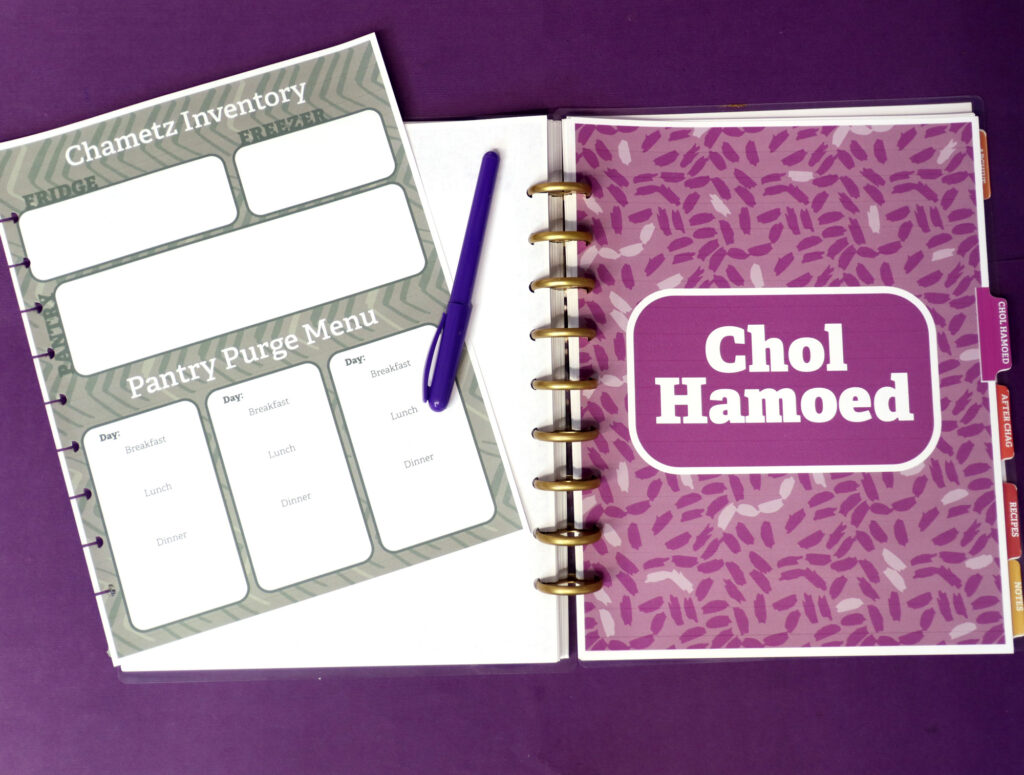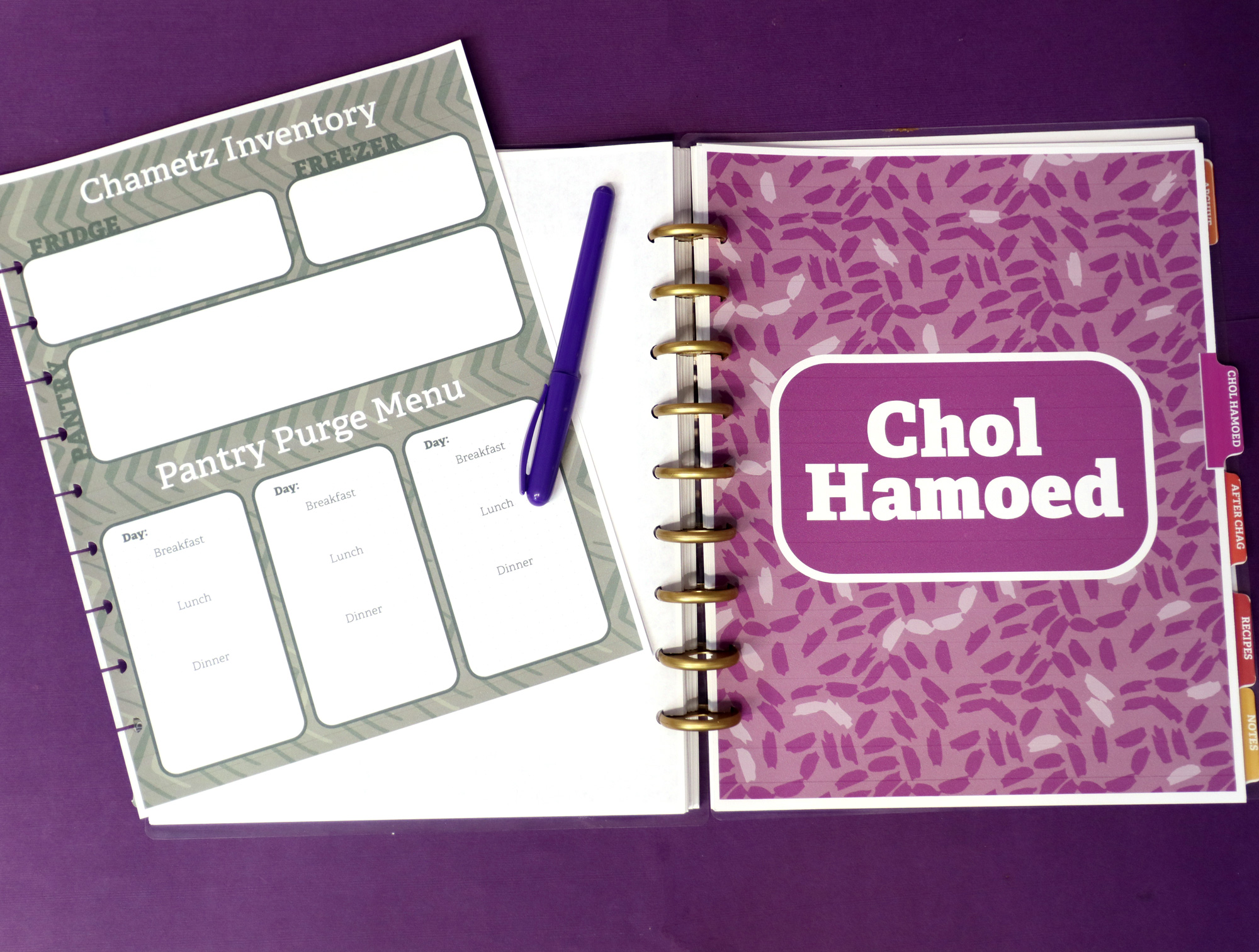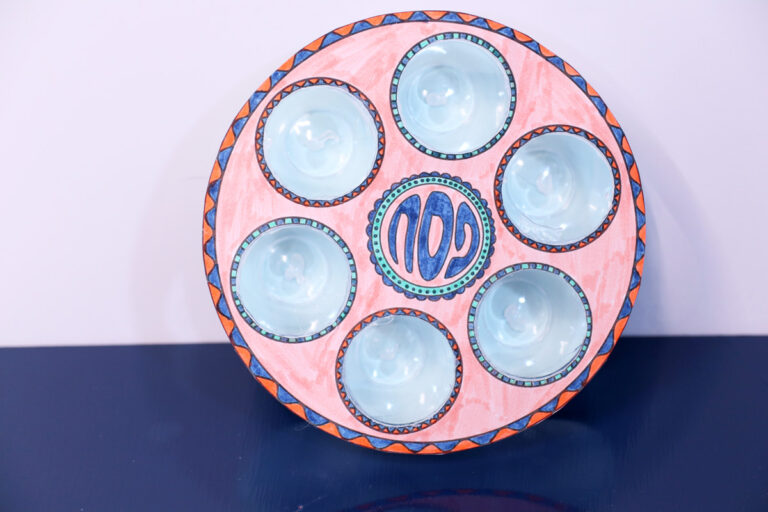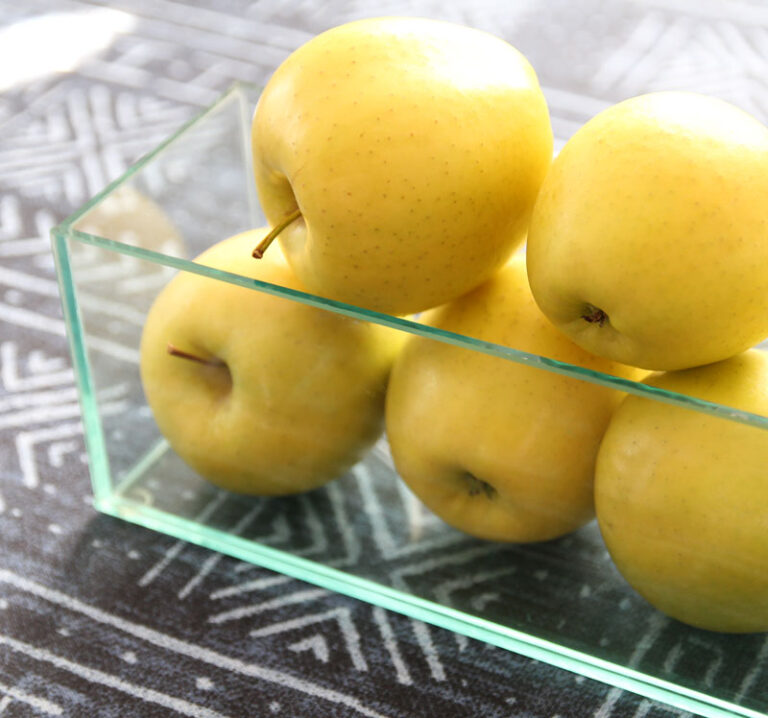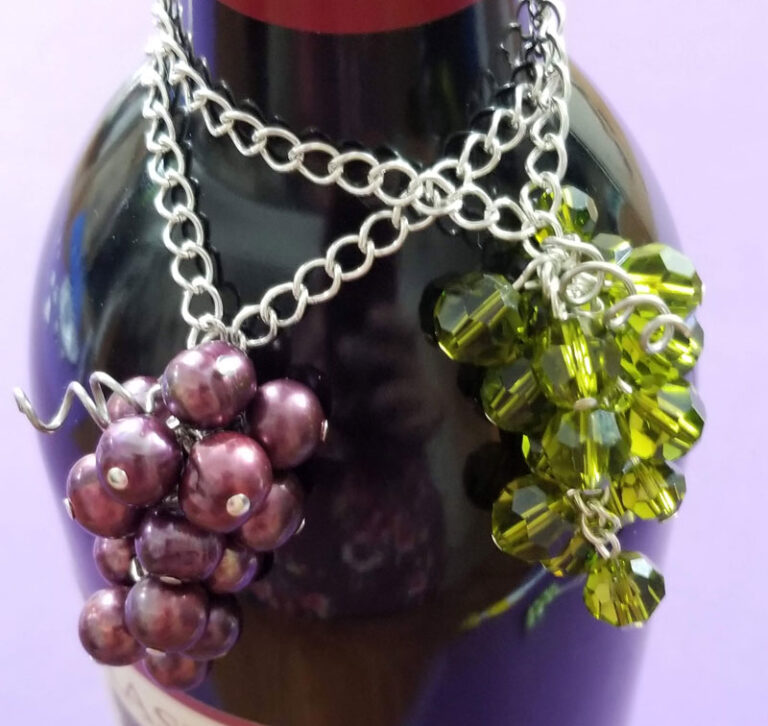Pesach Planned – Printable Passover Planner
I am thrilled to share with you my newest Passover planner – Pesach Planned! When you’re done reading, go ahead and check out our tips for making Pesach for the first time. This post contains affiliate links.
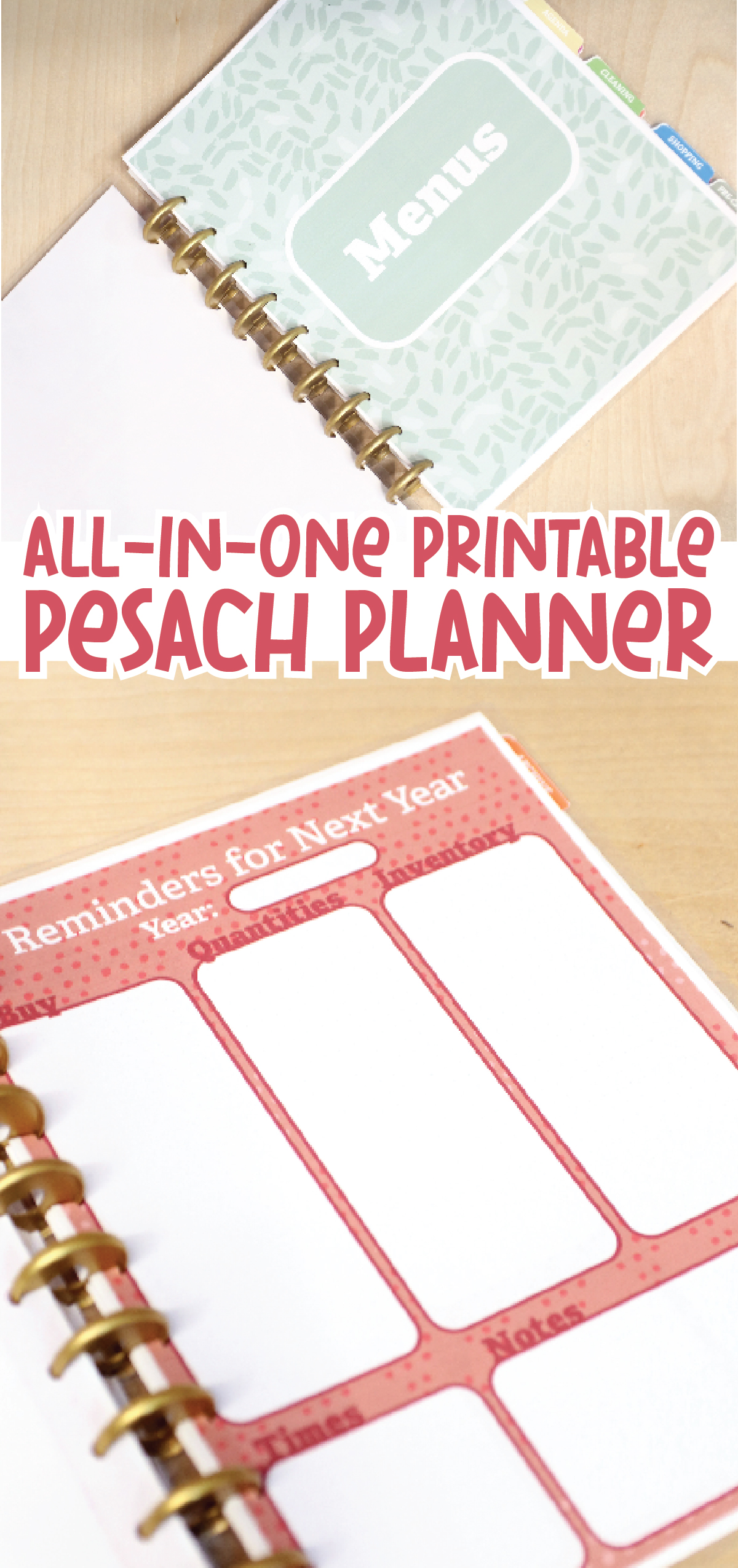
Paper planner peeps – I’ve got your back, for this Pesach and going forward! I am so excited to share the launch of Pesach Planned, a dot grid Passover planner for you to print and assemble into a binder.
Having all your lists and ideas in one place, within a repeatable framework that you can reference and update from year to year is a game changer when it comes to pre-Pesach sanity.
Get Pesach Planned
Pesach Planned is available directly from me here, or via my Etsy shop here. Purchase it wherever you feel most comfortable!
You can reuse Pesach Planned from year to year, reprinting only the pages you need, however, you may not share it with a friend or forward the files directly – each owner should purchase it directly (much like music or other digital products).
What exactly is Pesach Planned
Every year, I have scattered lists, emails sent to myself, Keep notes, and all sorts of things I forgot to save. I have docs with recipes, I have menus in various places – some on paper and some in Google Docs, and for good measure, there are even a few things in Evernote. Because why not COMPLETELY overwhelm myself?
The truth is, I’m a paper planner person.
I get distracted while using a screen, and yes, I actually enjoy sitting down with a planner, some pretty pens, and a coffee when I’m breaking. So using a paper planner isn’t really WORK for me, but it does save me TONS of work.

I designed this Passover planner to be everything I need it to be. As time went on last Pesach season, I jotted down all the pages I wished I had. I organized it into different categories, added some I thought others might want, and called it Pesach Planned.
The idea is to build a binder – a framework, really – one year, and use that to keep everything in one spot. The pages can be printed one at a time as you need them, or all at once.
You then place it in the correct section to sort it (visible by color coding.)
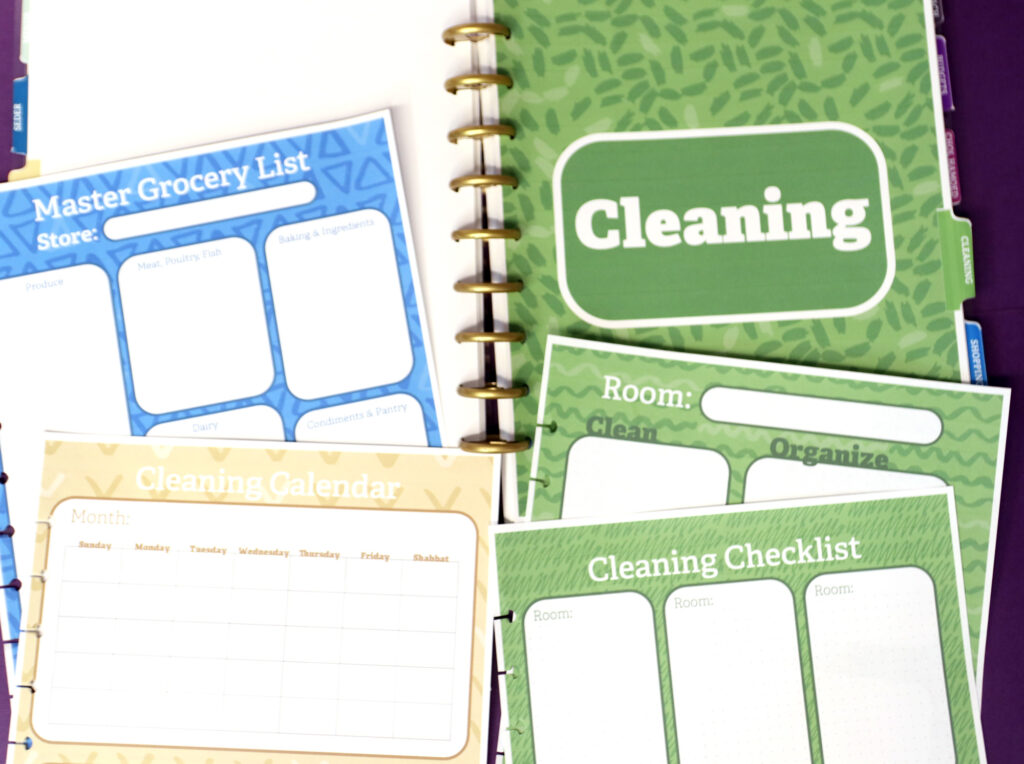
Pages
If you want a real, in-depth look at Pesach Planned, this is the video for you, but I’ll write my tips below as well:
The planner features front and back covers that were digitally illustrated by me. Dividers feature the same pattern and the backgrounds feature and assortment of patterns in themed colors.
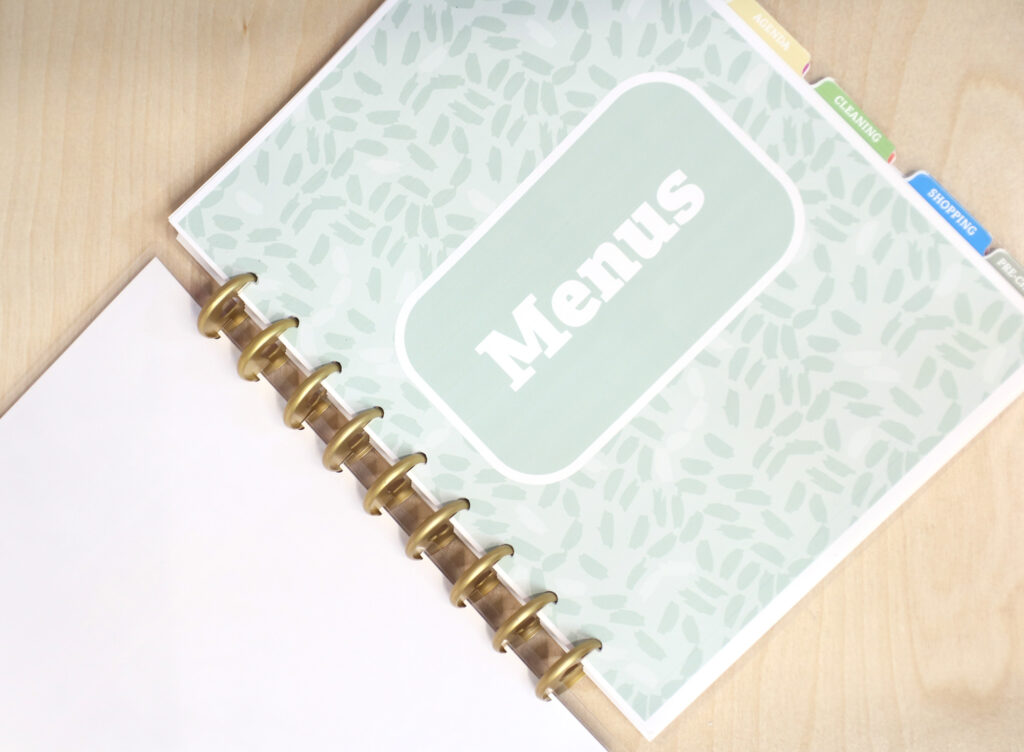
For example, everything in the menu section has the menu section color. You can, of course, switch things around as you’d like – it just won’t be themed anymore.
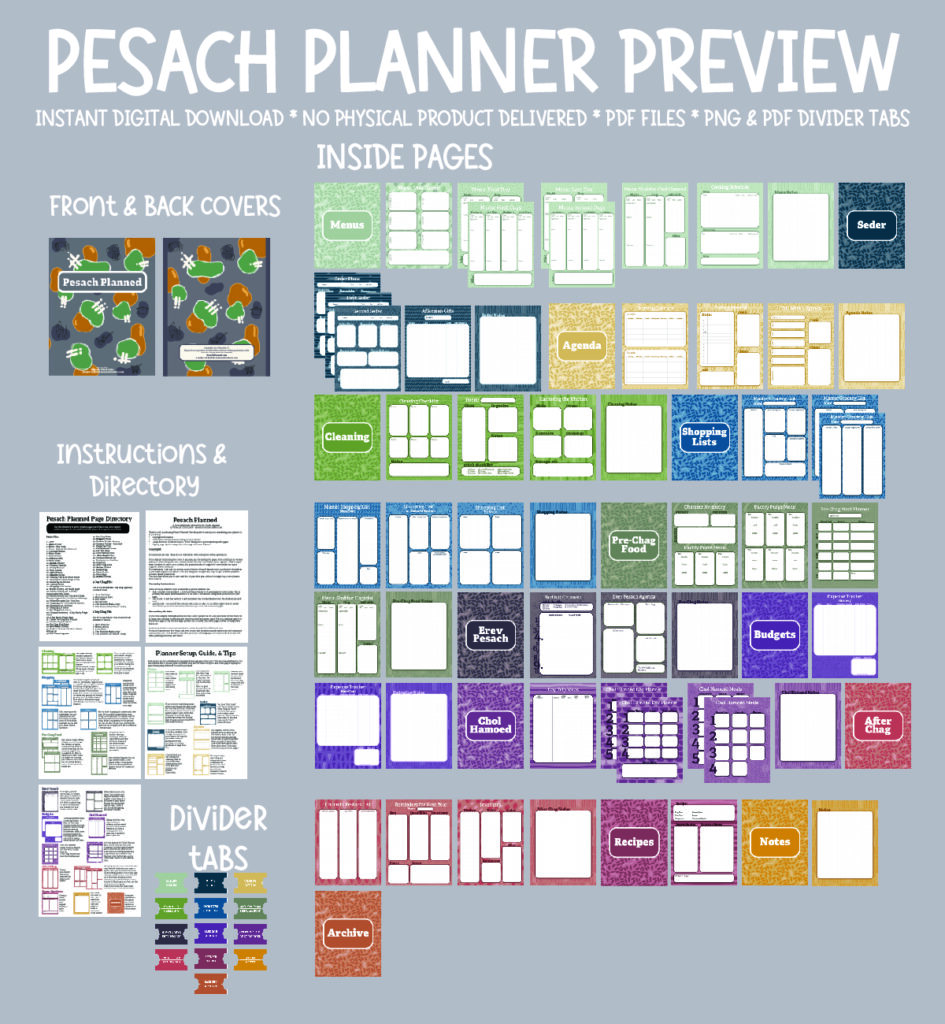
The Passover planner has 13 sections total, including: menus, seder, agenda, cleaning, shopping lists, pre-chag food, erev Pesach, budgets, Chol Hamoed, after Chag, recipes, notes, and archive.
Your download includes printable planner tabs as well, in both PDF and PNG format so you can hand cut or use your Cricut (if you have one) to Print then Cut.
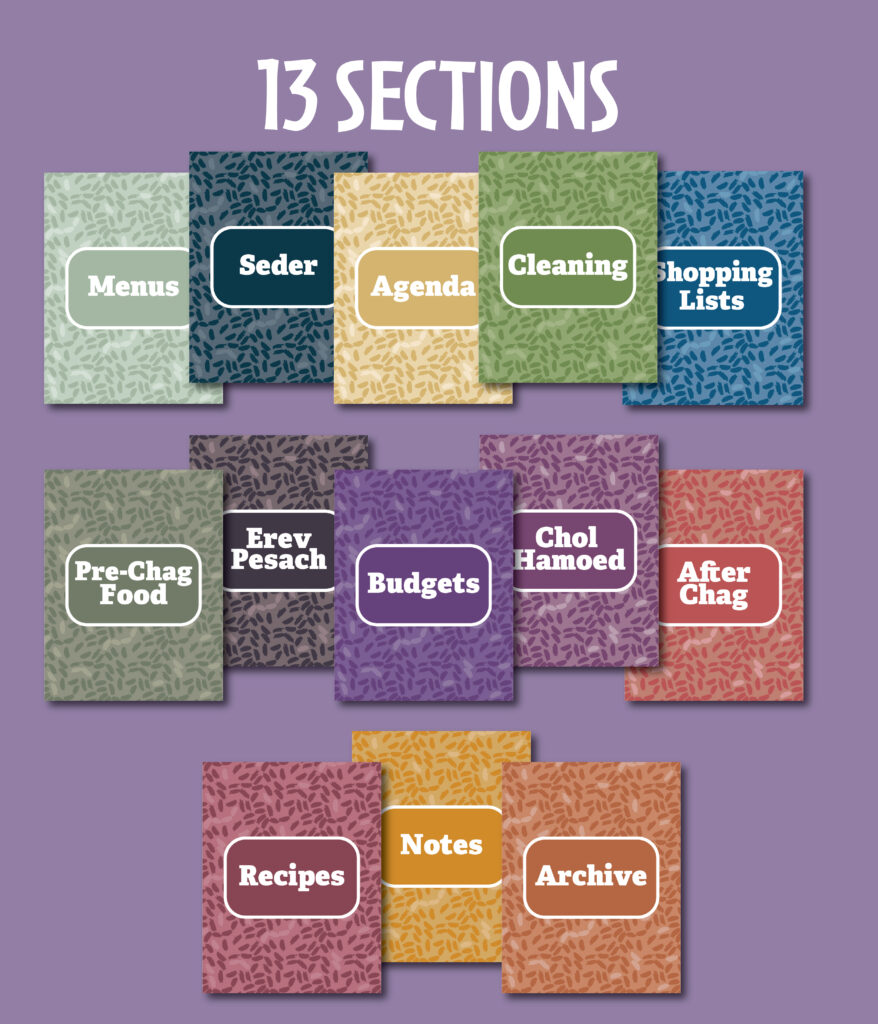
Menu Section
Menu section includes: An idea dump page to write down and categorize your ideas before putting them into the actual menu. I find that working this way keeps the menu itself cleaner, and ensures I don’t overdo things on the menu.
Then you have first days and second days menu plan pages at-a-glance, so that you can mount it somewhere visible and not move it all chag. For Israel, you have a two meal spread (first day/last day).
There is also a Shabbat Chol Hamoed page, and a cooking schedule. The schedule is designed for you to plan when you’ll cook it all – have a checklist for it, so you don’t scribble all over your menu. You can do this in the Agenda section instead if you prefer. The single-page layout gives you space to write things like cooking temp and more, so you do things efficiently.
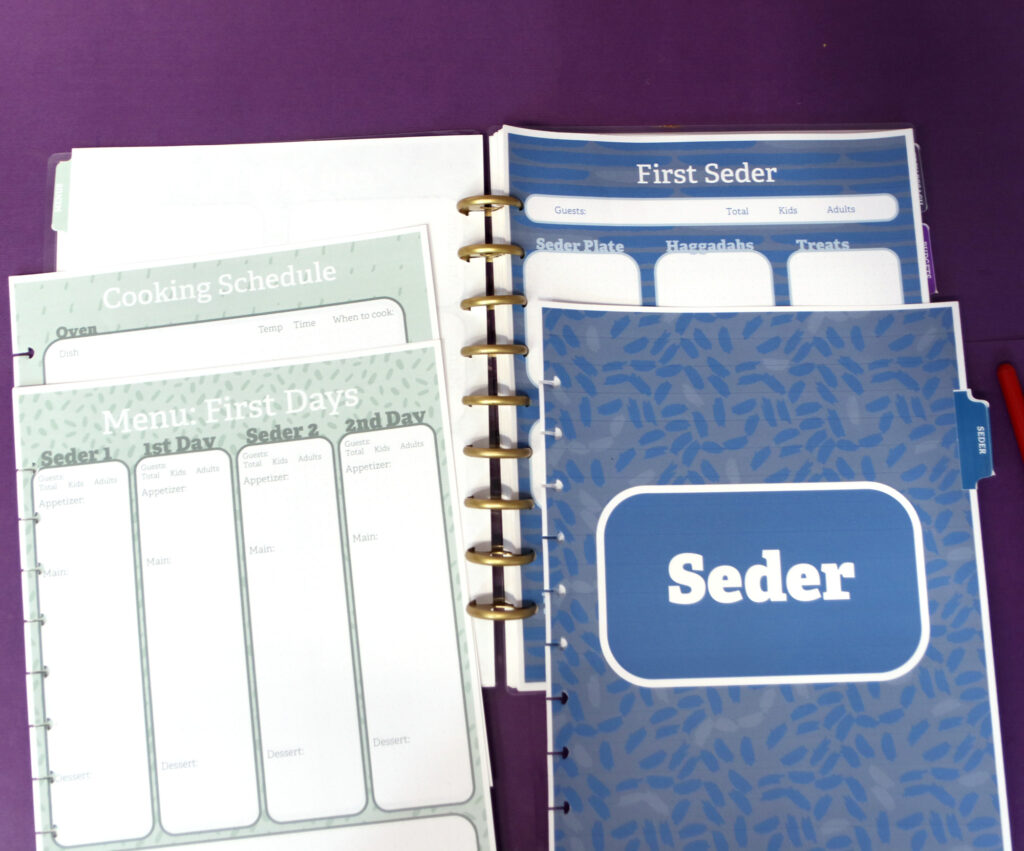
Seder Section
Seder pages allow you to plan seder-specific things, but not the menu. If you want, you can place the menu in the notes section.
The Afikoman gifts page is ideal for budgeters, those with large families, or grandparents who give gifts to multiple grandkids. We just buy whatever is negotiated seder night, so it’s not relevant to us, and I’ll be skipping that.
Agenda Section
Agenda pages feature a 2-month overview blank (undated) calendar, a weekly agenda with “cook” and “clean” sections, and daily agenda with cook, clean, eat sections.
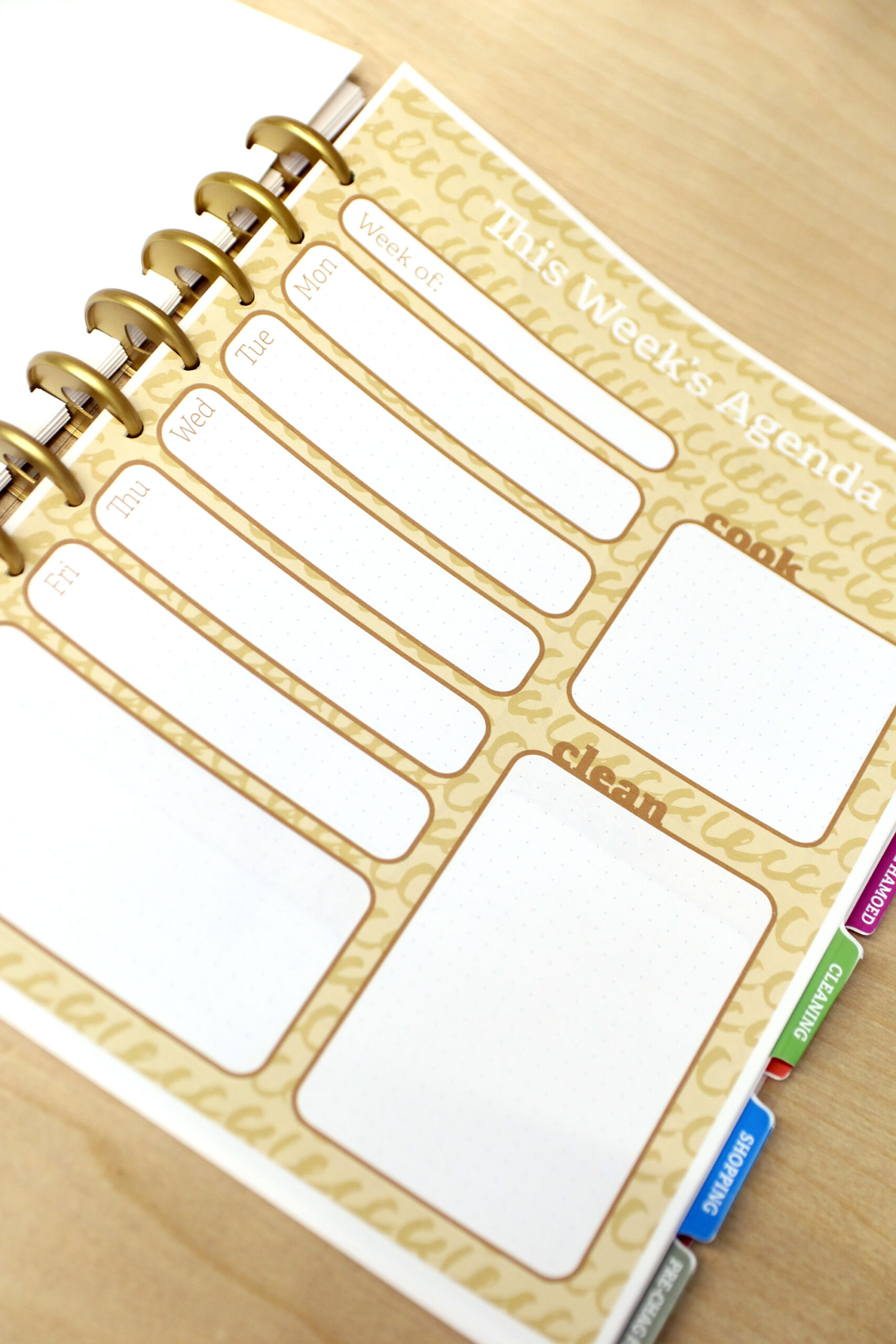
The monthly is very valuable for mapping out Pesach cleaning, kashering, and cooking timelines. Don’t get stressed by the two-month layout: you’ll likely need it even if you’re a 2-week Pesach planner any time Pesach falls out earlier than April 14… And for those who need more time, just print more pages.

Cleaning Section
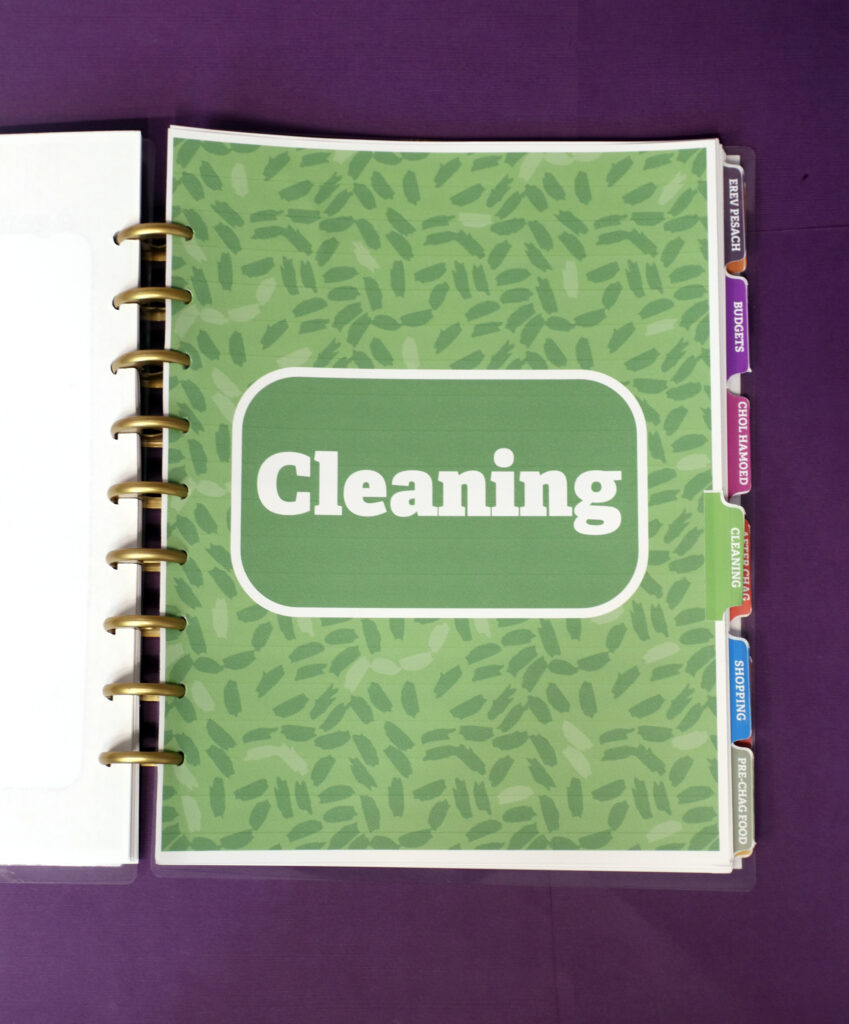
For cleaning, you have a checklist with a section for each room, a single-room page for in-depth cleans, and a page for kashering the kitchen.
These are BLANK pages – if you want one that is filled in, I also have available a master Pesach cleaning checklist you can download for free. It’s great to use alongside Pesach Planned.
Shopping Section
Shopping lists once again offers a single-page list, a list for groceries split into two for larger families, a non-food list, a by-store list, and a Chol Hamoed restock – so that you can pencil it in on that page as you create your initial list and work out your menu better.
Once again, these are blank lists. You can check out this master Pesach shopping list – another free printable that is fabulous to use alongside Pesach Planned.
Pre-Chag Food Section
The Pre-chag food section is my answer to “ma, there’s nothing to eat”. You have a Chametz inventory page with a pantry purge menu section on it, and then a separate 6-day pantry purge menu page. Even if you keep it simple (like frozen pizza simple), having a plan helps, and it’ll help you purge your freezer too!
There’s a more organized/dated pre-chag meal planner too if you prefer that, and it’s actually great for those days after you kasher before Pesach actually starts. Finally, there is Shabbat Hagadol menu planner, especially valuable this year, when Shabbat Hagadol is the day before Bedikat Chametz, requiring even most last minute people to be strategic with their menu.
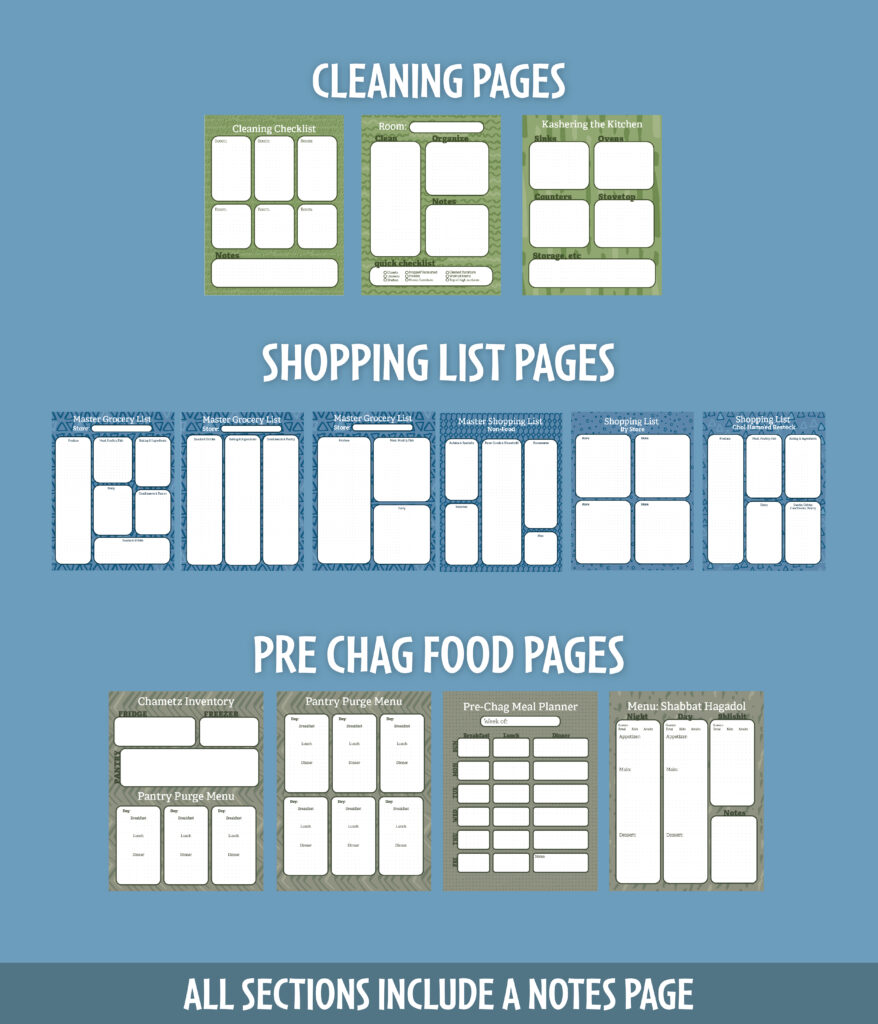
Erev Pesach Section
Among the shorter section, the idea of this one is just to put those pages where you need them; you may choose to skip this section entirely, or combine the section with others.
This section includes a bedikat chametz page with space to write where the ten pieces of bread were hidden. It also includes a quick checklist. It also has an Erev Pesach page (which can be added to the agenda section if you prefer it there.)
Budget Section
Keeping track of expenses is a big deal Pesach time, when things tend to cost WAY more than they normally do – both because of the festive holiday meals, and because of all the new things that are often needed.
Grocery and non food budget pages can be printed as many times as you need to keep your finances in order. It’s organized so that you can mark how you paid for it (for example, using which credit card) so that you can stay on top of things.
Chol Hamoed Section
If you’re the type of family that can’t decide until noon what you’ll be doing on Chol Hamo’ed, the first page – a day trip idea dump page is perfect for you! List your ideas with all the pertinent details and work from there.
The day planner is the one I’ll be using, as my husband will likelybe working, so I’ll be planning at-home activities instead. It has space for meals too, as well as a to do/prep section (which is spot-on for years like this one, where Shabbat Chol Hamoed is smack in middle).
Finally, you have a Chol Hamo’ed meal planner. Even if you don’t usually meal plan, on Pesach, you’re less likely to have a good supply of what you need, and having a meal plan can prevent lots of crankiness down the line.
After Chag Section
Arguably the reason I created Pesach Planned was to have this reference from year to year. The After Chag pages are really valuable, both in saving time and money, and in eliminating stress.
First, you have a chametz restock shopping list. This is ideally filled out when you start pantry purging and referred to only after chag.
Then, the “reminders for next year” page includes things you’d like to buy for next year (as in, kitchenware you feel you need/broke, or just foods you were missing this year. It has space to write down quantities of things that you used (matzah, wine/grape juice, potato starch/matzah meal, etc), inventory (such as spices you are freezing for next year), times (when the seder started/ended, for example), and notes.

The inventory page gives you plenty of space to write a detailed inventory of everything you have for Pesach so that you can reference it even before you’re ready to unload your Pesach boxes.
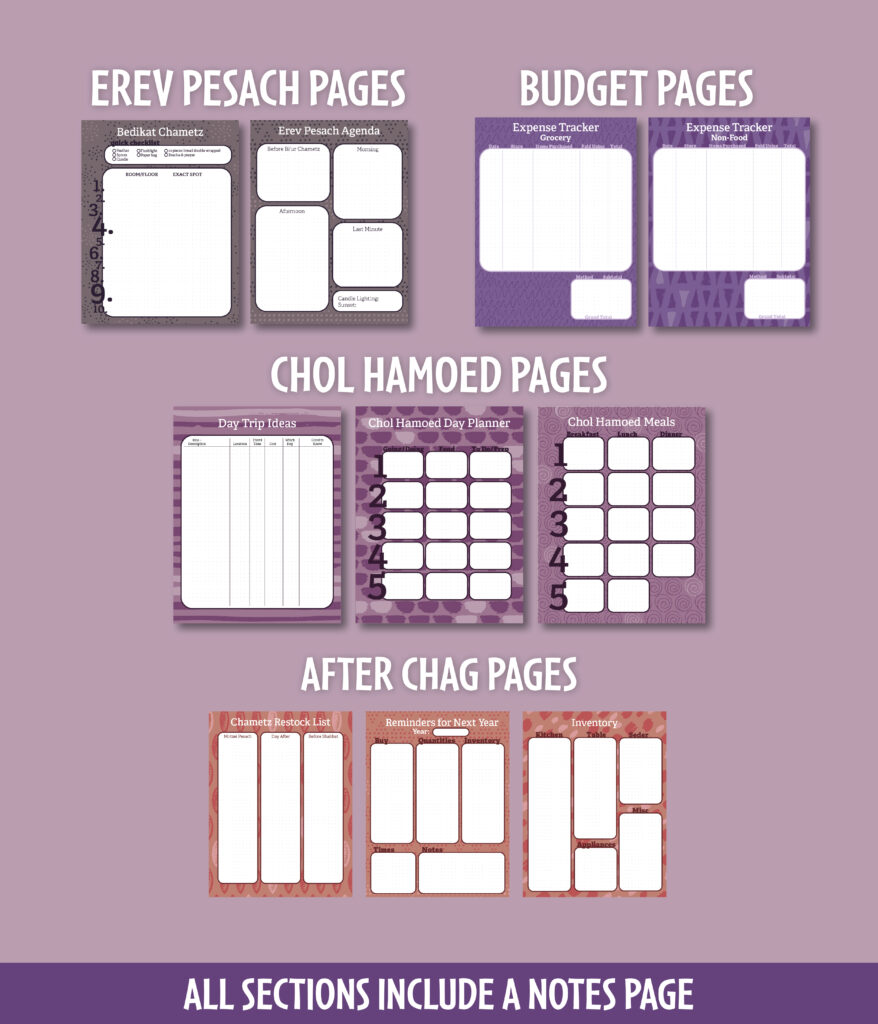
Bonus Section
To complete this as a well-rounded Passover planner, I added a recipes section with blank recipe pages so that you can jot down your favorite Pesach recipes, and have them stored in one spot.
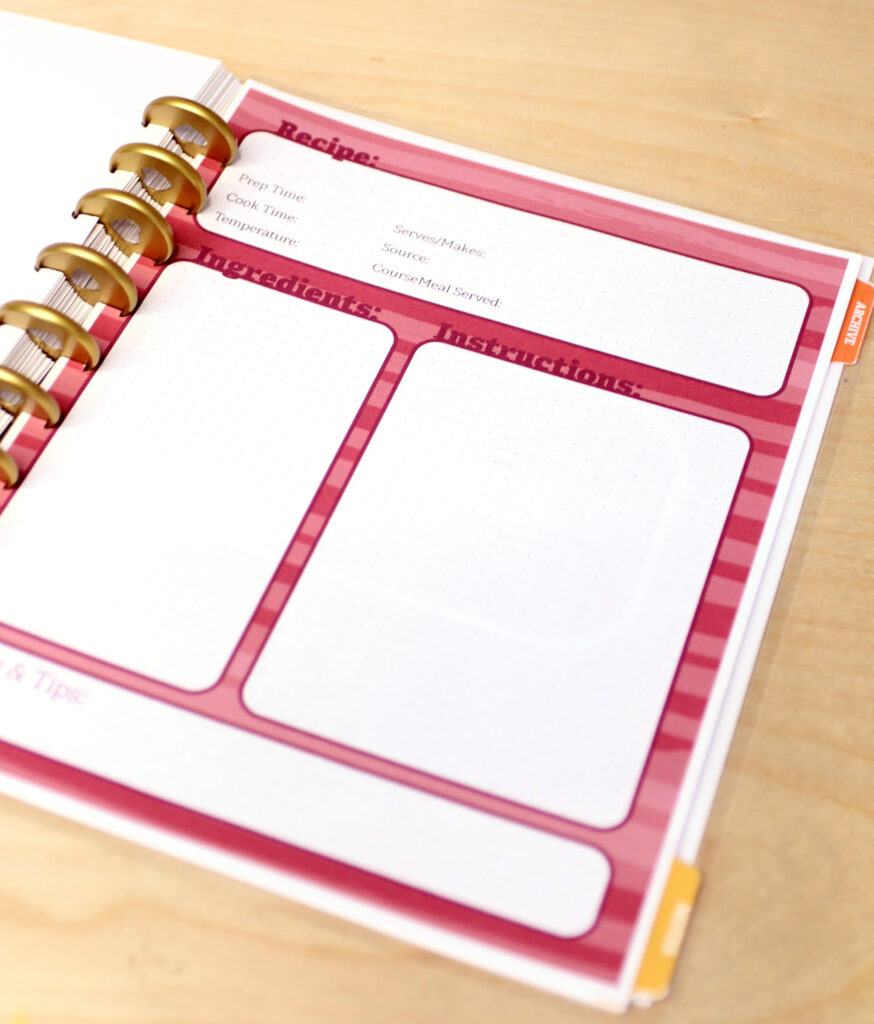
A notes section is simply a place to write any random notes – that’s all. It’s a notebook at the end. (Each section has a dedicated notes page as well).
And the archive section is just a divider – and a spot to dump previous years’ menus, cleaning lists, budgets, and more.
Features
I created Pesach Planned to really be the one and only Passover planner you might need. The pages are flexible, and the style is really cheerful, to bring some light into your Pesach prep endeavors.
Here are some key features:
- Dot grid: To keep things pretty, flexible, but still provide you guidance, all writing areas have a faint dot grid. This is a top choice among bullet journalists (and me) because it keeps the page visually clean, while still providing the benefits of a ruled paper.
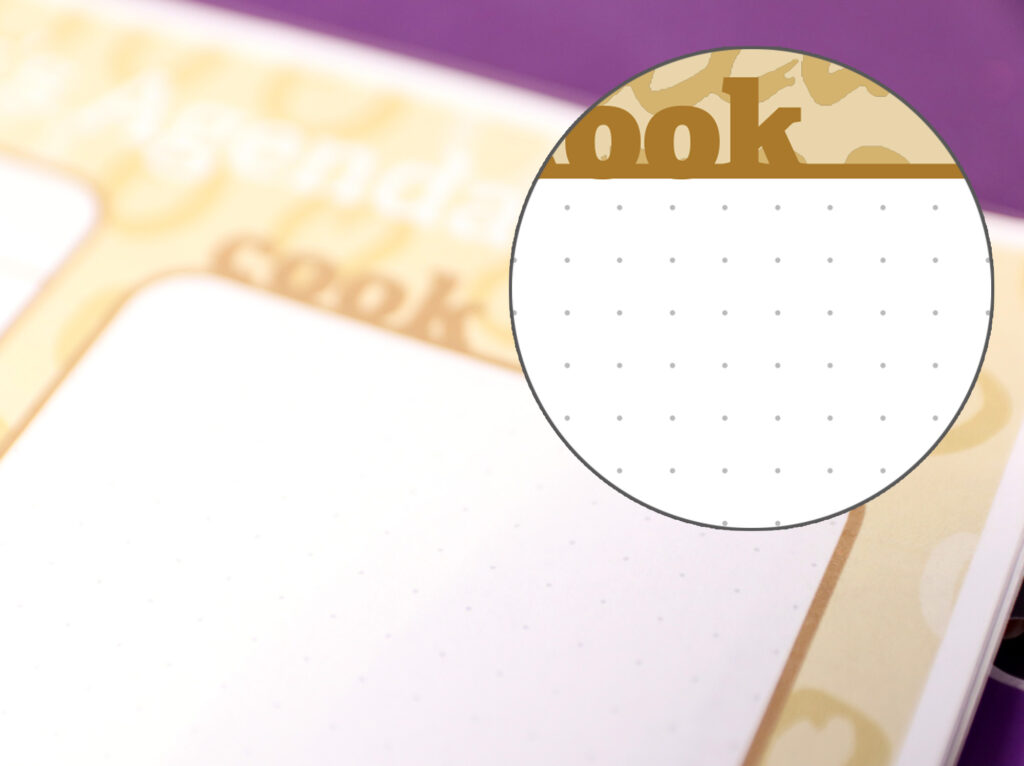
- Divider pages: Even if the only thing you use is the divider pages, it’ll still help you organize! Since there are a LOT of lists involved in Pesach planning, having them in a convenient place to find what you need when you need it is so helpful.
- Divider tabs: while you can totally just use tabs from the office supply section of the store, I did provide both PNG (Print then cut) and PDF versions of tabs that you can fold over and place on your divider pages.
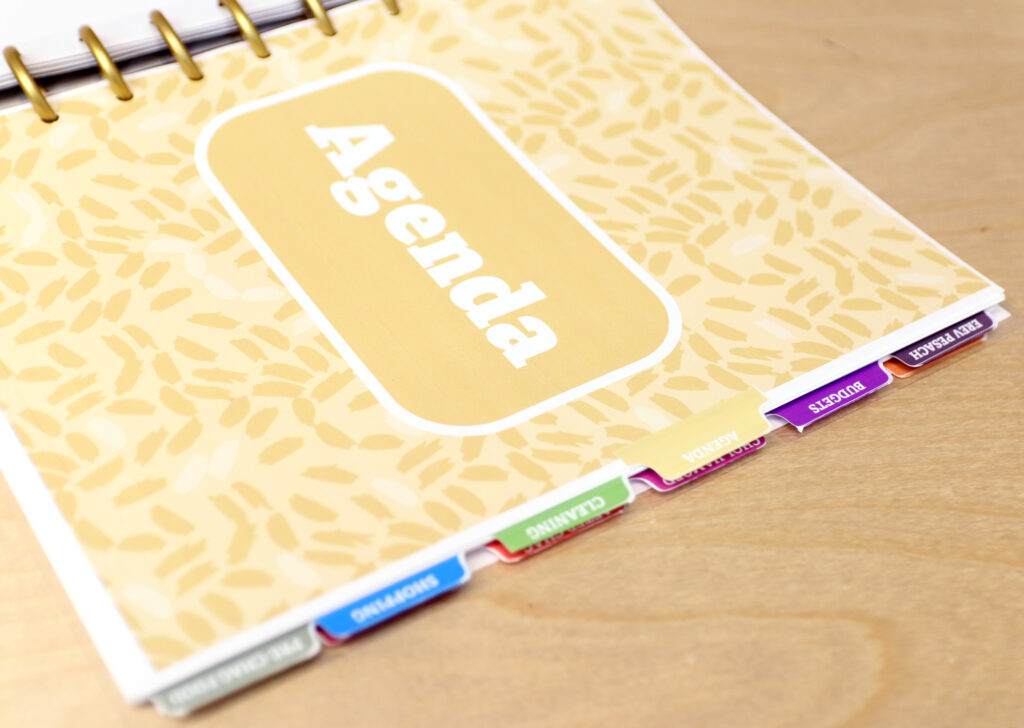
- Easy framework for organizing: Since the entire Passover planner is color coded, it’s easy to place things where they belong.
- Illustrated front and back covers– I digitally illustrated subtle and quirky Pesach images set on a bold and playful pattern that is meant to add a heavy dose of FUN to your Pesach prep.
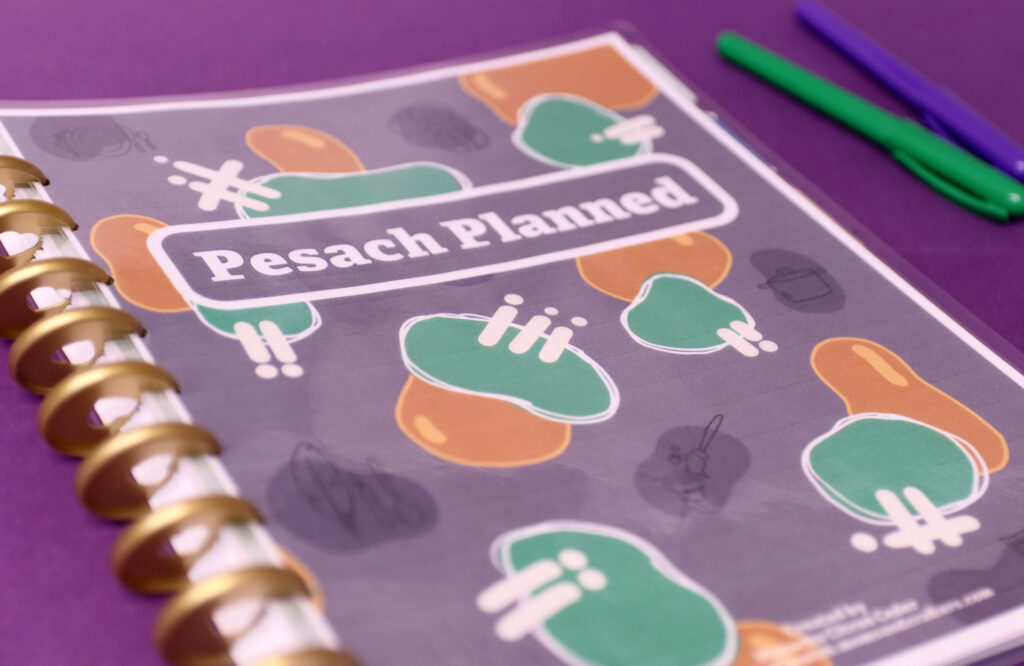
- Page directory – part of the point of Pesach Planned is to help you with the lists you’d anyway create. A favorite way for ME to do this is to print list pages as I need them. So I provide a directory of pages so that you can choose to print pages individually as you need them.
- Each section has a notes page dedicated to it, so if I missed something, you can add a page that’ll fit right in and be easy to sort!
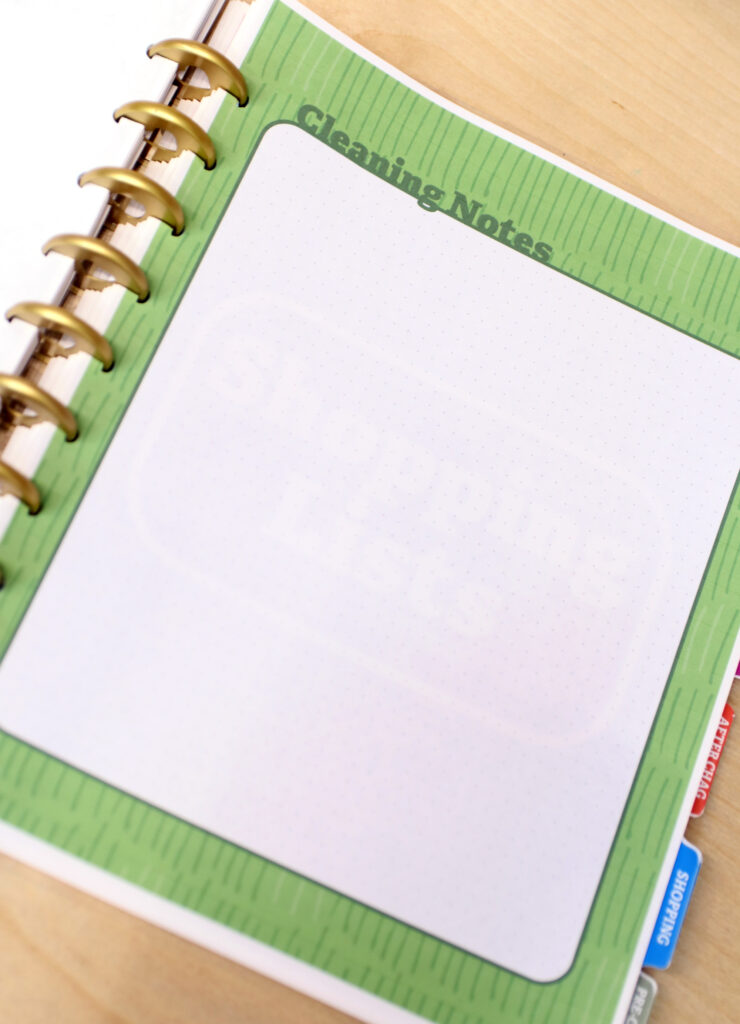
Assembling your Passover Planner
You can watch the video where I showcase how I assembled Pesach Planned, or scroll down for deets.
In a binder
My recommended way for you to set up your Passover planner is in a binder, with sheet protectors. This prevents oopsies, allows you to place pages back to back, rearrange them without compromising page quality, and more.
In fact, I bound mine using a disc-bound system (shared below) and already had one oopsie where I had to reprint pages.
You can either laminate your divider pages and add tabs, or add them to sheet protectors too and attach the divider tabs on top.
I printed my divider tabs on printable vinyl and cut them using my Cricut. You can also print the PDF file directly on sticker paper, on cardstock, or whatever you’d like, and cut them out by hand.
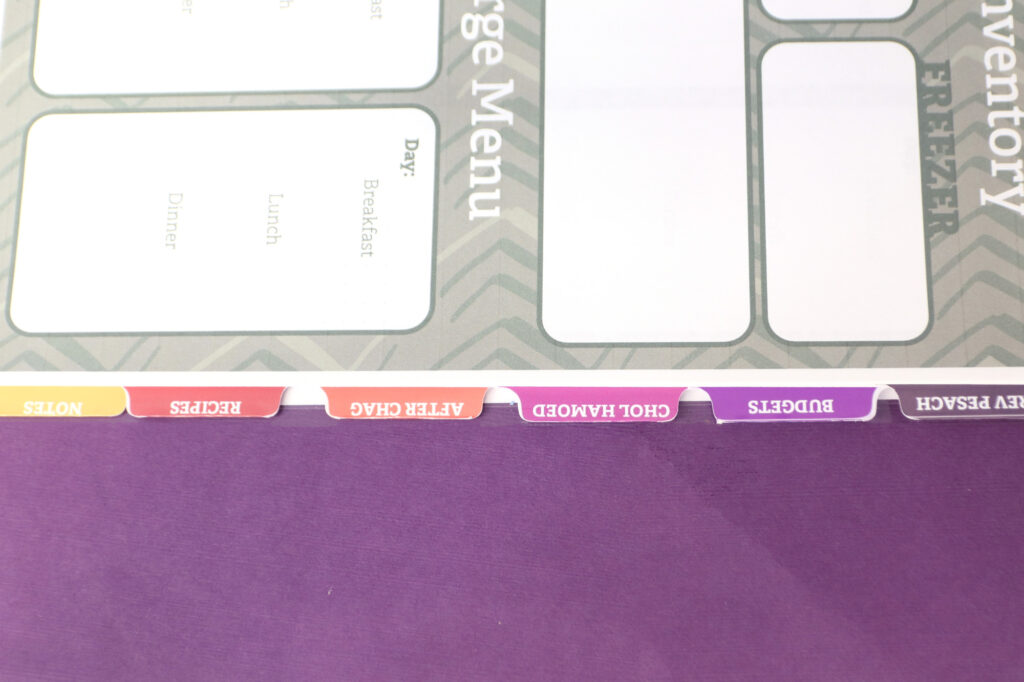
Or, get divider tabs and write in your sections.
Disc Bound
I used a disc bound system to assemble Pesach Planned. I enjoy using a disc-bound system for day-to-day planning (I am a Happy Planner user) and had leftover discs from old binders, as well as a disc hole punch.
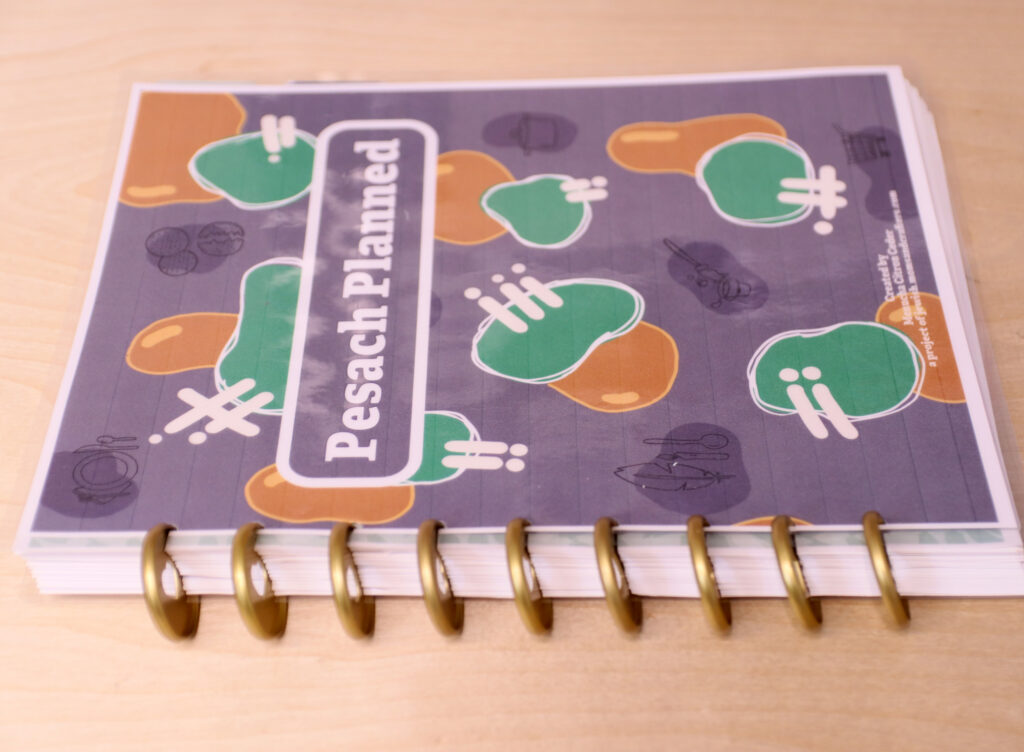
The biggest advantage of using a disc-bound system to assemble your Passover planner is that it takes up much less space.
The drawback: your pages are unprotected. It’s also more work.
My advice: if you tend to use the pages as standalone pages and then organize them into the binder, a binder is better. If you keep your pages where they belong, a disc-bound system, or similar, might work well for you. Just make sure not to place it anywhere it may get wet.
Hard laminate your front and back covers to serve as functional covers.
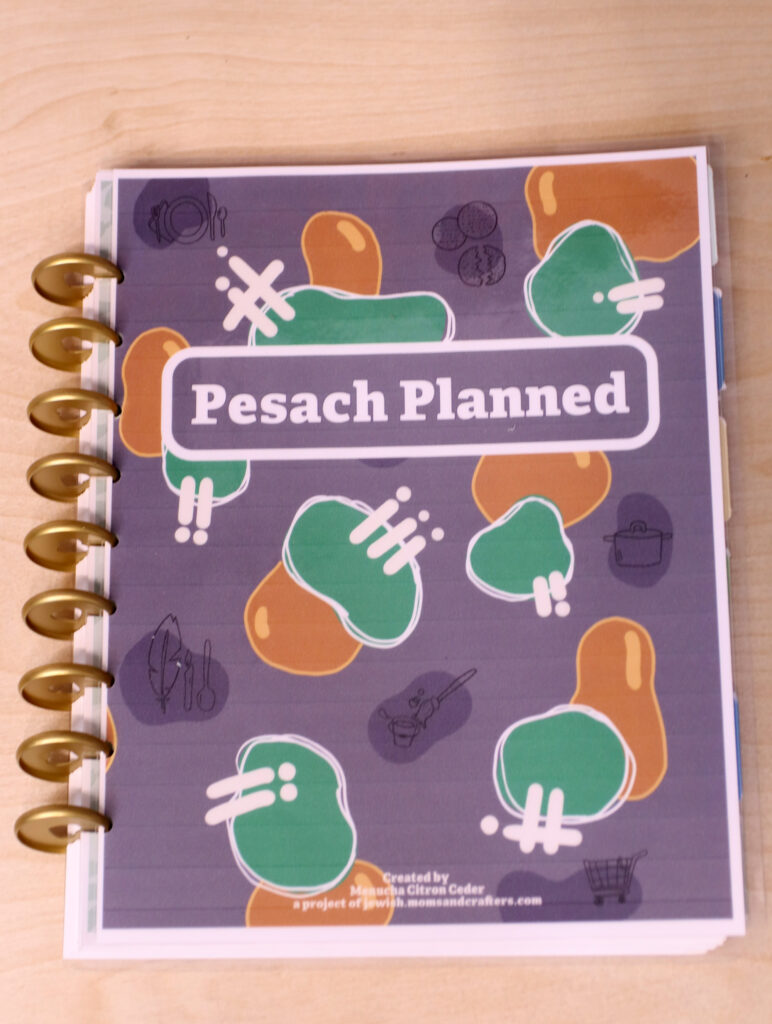
I used cardstock for the divider pages, and added the tabs directly on them.
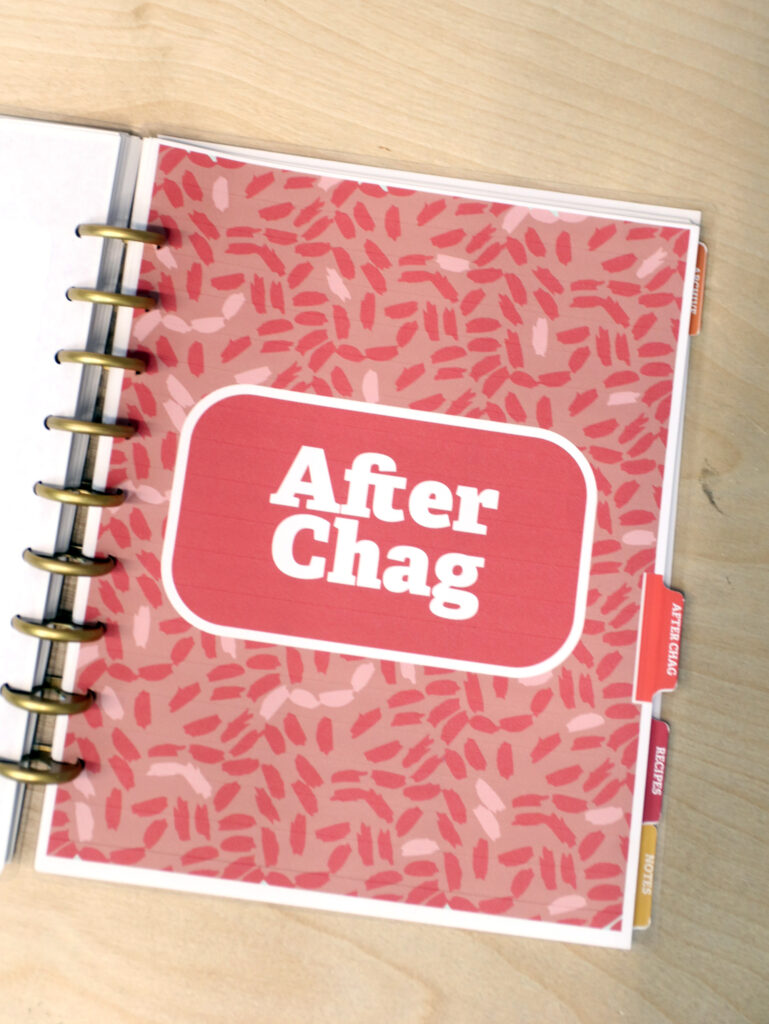
However you choose to assemble your Passover planner, I do recommend choosing a system where you can add and remove pages.
How Pesach Planned can help YOU
Still on the fence? Need a bit more to justify splurging on a Passover planner, and setting aside time at the most hectic period of the year? Here’s a list of ways Pesach Planned can help you.
Save time
- Knowing how much of quantities used saves you from extra grocery runs when you run out of matzah mid-way through Pesach.
- Recording how many cups are in a bag of potato starch (for example) will once again allow you to bake more efficiently and save you extra grocery runs.
- Having a more organized framework for menu planning, as well as a place to keep records, gives you a more realistic image of what you need to make. For example, you can store past menus in your archive both to reuse ideas from year to year, and to reference how the quantities of dishes you cooked worked out for the amount of guests you had. So if you always feel like you don’t have enough food, this can save you DAYS of cooking time.
- Working through how to clean your house most efficiently using various list orders.
- Keeping a list for Kashering the kitchen helps you remember what you need to do from year to year (make it with a Rabbi’s guidance the first year, and save it in the archive section to copy from in future years).
- Saving your master shopping list from year to year, and having an organized framework for it, can once again save you time spent running to the store because you forgot something.
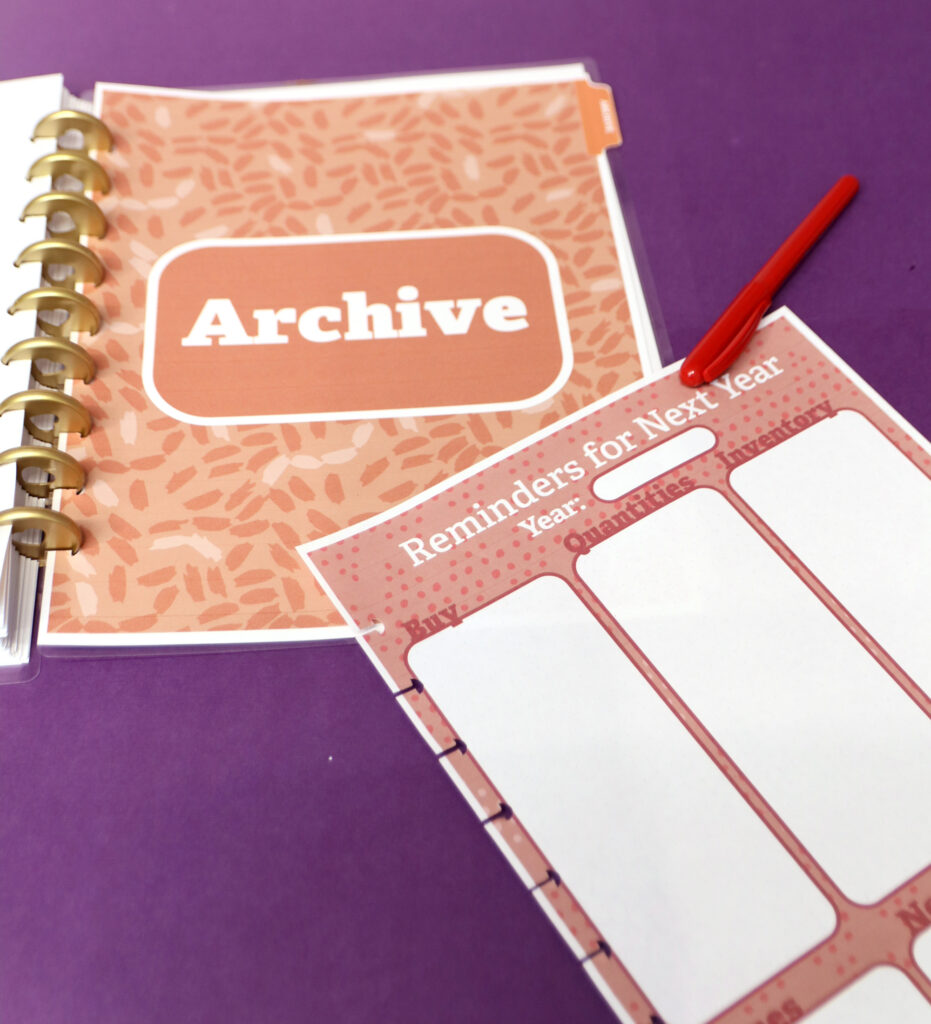
Save money
- When it comes to saving money, there is a lot of overlap in the saving time – only it’s an issue when you buy too much of things. No more piles of leftover matzah, matzah meal, and Kosher for Passover ketchup. Knowing how much cheese you used last year, with how many people in the house, will help you gauge better and avoid overspending on pricey cheeses that no one will eat.
- In addition, with EFFICIENT menu planning, you avoid overdoing it. There’s nothing as budget-busting as throwing out expensive meat dishes because you thought you needed way more food (or forgot that no one is actually hungry by the time Shulchan Orech comes around seder night).
- OF course, the budgeting pages can give you a more realistic take on the impact it may be having on your wallet, and allow you to step back a bit and cut corners as needed.
- There were times when I “remembered” that I needed something for Pesach, but forgot that I had actually bought it Black Friday when I saw a sale… keeping an inventory is a wallet-saver. The inventory page included really helps, but even if you don’t use that, shopping only off your “buy next year” list and crossing things off as you get them can help.
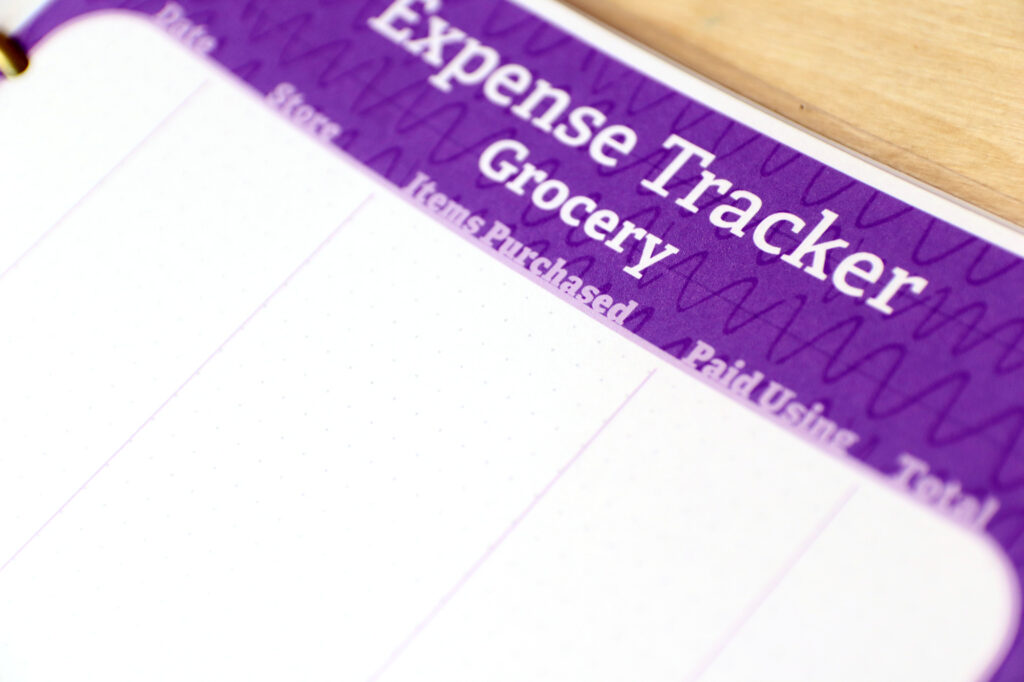
Save sanity
- Having a clear cleaning and cooking timetable can really help you visualize when things need to get done, if you’re on the right track.
- Keeping lists of what you need, what you have, etc. can help you avoid digging through boxes before you’re ready.
- Just being able to find those things where you put them, remember the details from last year that will save your sanity…
- Did I mention not overdoing the menu? Can you guess what my personal weak spot is?!
- Having those meals that you tend to forget about planned out, a list of chametz, and more details that sometimes fall under the radar tended to saves loads of sanity.
